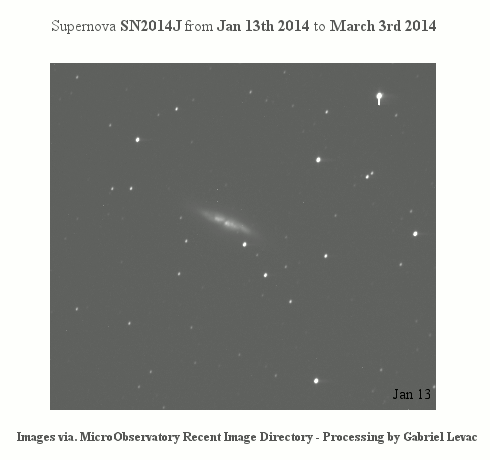SN 2014J is a type-la supernova that appeared in Messier 82 in mid-January of 2014. The supernova was accidentally discovered by a group of observers at the University of London Observatory, and is the closest supernova of its type observed in the past 42 years.
This supernova is being heavily imaged by both amateur and professional astrophotographers and astronomers, and is also being observed by many backyard astronomers, as it is visible in many smaller telescopes.
As for myself, heavy cloud cover and cold temperatures have prevented me from imaging the object with my own equipment, but I was lucky enough to order an exposure of M82 on January 13th 2014 from MicroObservatory. The image I received was captured two days before the supernova first appeared, and although it did not feature the supernova, it did inspire me to create my first .gif of the event on the 22nd of January when the astronomy community was first alerted to the presence of the supernova. I ordered another frame from MicroObservatory, but I was not fully satisfied with simply showing the SN disappearing and reappearing in two frames taken days apart.
MicroObservatory features several user controlled telescopes which can be used by the public to image an object of their choice from a list of objects curated by OWN. OWN also maintains a full catalogue of images taken within the past two weeks, including both FITS and .gif files.
In order to get enough material to produce a relatively smooth animation of the progress of the supernova, I sifted through the public requests in order to find daily images of M82 starting from the 14th of January, and collecting images up until March 3rd. I was able to collect 40 frames in total, and only missed a few days where images were unavailable or unusable.
The final image demonstrates the initial rise in brightness (maxing out on the 29th of January) and the following decrease (the supernova is still visible, although it is becoming dimmer).
In order to get enough material to produce a relatively smooth animation of the progress of the supernova, I sifted through the public requests in order to find daily images of M82 starting from the 14th of January, and collecting images up until March 3rd. I was able to collect 40 frames in total, and only missed a few days where images were unavailable or unusable.
The final image demonstrates the initial rise in brightness (maxing out on the 29th of January) and the following decrease (the supernova is still visible, although it is becoming dimmer).
The resulting image is displayed below:
Processing:
The image is a bit jumpy, and the brightness of both the supernova and the galaxy vary a bit between frames. The majority of these issues were caused by problems with atmospheric clarity and misalignment between telescopes.
First of all, I imported all the FITS frames I had downloaded from MicroObservatory into their custom software MicroObservatory Image, which I used to bring the images to an approximate level of brightness, then to export into individual .gif frames.
Then I imported all 40 frames into GIMP, and ordered them correctly.
I then made sure that the galaxy and background looked approximately the same in all the images (getting all the frames perfect was pretty much impossible), and aligned the images so the galaxy would stay in approximately the same spot (the tracking on the MO telescopes isn't perfect, and there's usually a fairly large difference between frames with several days between them).
Once this was done, I added the date markers to the bottom right of the image, and added the frame with the correct attributions and labelling.
All in all, this project probably took me 4-5 hours in total to complete, but the final result does exactly what I wanted it to, so I say, time well wasted!
Please take the time to check out MicroObservatory if you have an interest in astronomy or astrophotography! It's a fantastic way to get good data and get started in the hobby!
Another shout out to /r/astrophotography, which has proven to be a wonderful resource for a learning astrophotographer like myself! It's populated by helpful people, and a ton of fantastic imagers!
First of all, I imported all the FITS frames I had downloaded from MicroObservatory into their custom software MicroObservatory Image, which I used to bring the images to an approximate level of brightness, then to export into individual .gif frames.
Then I imported all 40 frames into GIMP, and ordered them correctly.
I then made sure that the galaxy and background looked approximately the same in all the images (getting all the frames perfect was pretty much impossible), and aligned the images so the galaxy would stay in approximately the same spot (the tracking on the MO telescopes isn't perfect, and there's usually a fairly large difference between frames with several days between them).
Once this was done, I added the date markers to the bottom right of the image, and added the frame with the correct attributions and labelling.
All in all, this project probably took me 4-5 hours in total to complete, but the final result does exactly what I wanted it to, so I say, time well wasted!
Please take the time to check out MicroObservatory if you have an interest in astronomy or astrophotography! It's a fantastic way to get good data and get started in the hobby!
Another shout out to /r/astrophotography, which has proven to be a wonderful resource for a learning astrophotographer like myself! It's populated by helpful people, and a ton of fantastic imagers!


No comments:
Post a Comment